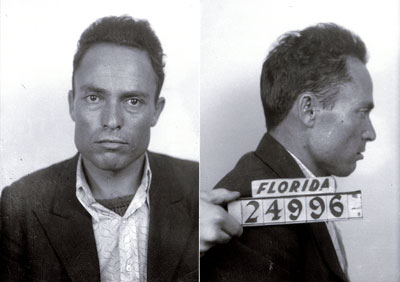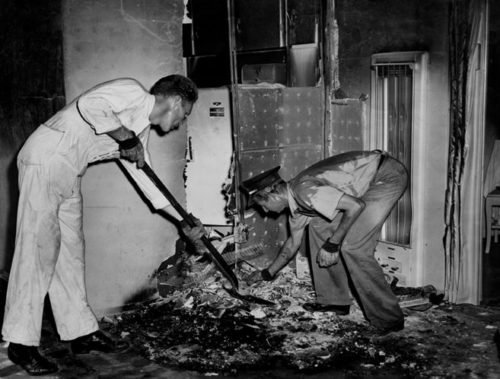WCAG Heading
by Craig Pittman
WCAG Heading
Giuseppe “Joe” Zangara: FDR’s Assassin
In my time covering courts, I tracked down the grave of Giuseppe “Joe” Zangara, a bricklayer who in 1933 tried to assassinate President-elect Franklin Roosevelt after a speech at Miami’s Bayfront Park. Zangara was unstable, in more ways than one. He perched on a metal folding chair twenty-five feet from the car where FDR sat. As he took aim, he yelled, “Too many people are starving!” and emptied his pistol.
But a woman next to Zangara, Lillian Cross, grabbed his arm and beat him with her purse, spoiling his aim. Every shot missed FDR. One bullet killed the mayor of Chicago, Anton Cermak, who’d created the Windy City’s Democratic political machine.

Giuseppe Zangara mugshot.jpg
More details
Mug shot of Giuseppe Zangara. By Florida Department of Corrections. Image is in the public domain via Wikimedia.com
“I don’t hate Mr. Roosevelt personally!” Zangara told the cops. “I hate all officials and anyone who is rich.”
Within a month of Cermak’s death, Zangara was tried, convicted, and executed, a record that still stands. His last words to the executioner were, “Push the button.”
When I located his marker, it showed how far Zangara has fallen into obscurity: His last name was misspelled.
I suspect there are more strange ways to die in Florida than anywhere else. I’m not talking about being cooked to death in a condo sauna or smacked in the face by a leaping sturgeon or getting trapped in a pet door or blowing up in a hyperbaric chamber for horses (yes, those all happened).
Mary Reeser and Spontaneous Human Combustion
I mean a death that’s really strange, like the incident in 2012 when a man died while winning a Deerfield Beach pet store’s roach- eating contest. The first prize was a python. The medical examiner said the man choked on insect parts. Where, I wonder, is that box on the official “Cause of Death” form?
One of the most famous cases of “spontaneous human combustion” occurred in St. Petersburg in 1951. A widow, Mary Harder Reeser, went up in flames. The FBI said she fell asleep while smoking, setting fire to her chair, yet no one could explain why a pile of newspapers next to her never ignited.

Sometimes what’s unusual is what happens after death. In 1991, after a sixty-five-year-old man died of a heart attack on the sixteenth green of a Winter Park golf course, the police (after some debate) covered the body with a sheet and let other golfers play through.
St Petersburg Zombie Cat
It could be worse. In 2015, a guy in St. Petersburg buried what he thought was a dead cat in his yard, only to see it five days later wandering around like a zombie.
That cat was lucky. In Florida, acting like the undead can get you killed. Look what happened with Rudy Eugene, who during the Memorial Day weekend of 2012 stripped naked and attacked a homeless man on Miami’s MacArthur Causeway, chewing off his face and growling at anyone telling him to stop. Finally a cop shot Eugene and rescued the victim. Initially Eugene’s behavior was blamed on a new drug called bath salts, but eventually toxicology tests revealed that the only thing he’d taken prior to getting zombified was plain old Mary Jane.
First Female Serial Killer in American History
For Floridians, one frequent cause of death seems to be falling prey to a serial killer. We’ve had plenty, because our constantly transient population means plenty of potential victims.
Thus we had Aileen Wuornos, dubbed “America’s first known female serial killer,” a prostitute who let lonely men pick her up, and then murdered at least seven of them. She said she “flat robbed, killed them, and there was a lot of hatred behind everything.”
Her case inspired the movie Monster, which won star Charlize Theron an Oscar. She continues to attract visitors to the Last Resort, the Port Orange biker bar where Wuornos drank her last beer. In addition to admiring her framed photo, you can buy T- shirts and bottles of hot sauce with her likeness.
We also had the Gainesville Ripper, Danny Rolling, a cop’s son who confessed to killing eight people, decapitating one and posing several others to create a more dramatic scene. Rolling’s bloody spree inspired Kevin Williamson’s script for the movie Scream, which rejuvenated the horror genre.
We had Ottis Toole, a Jacksonville native who was convicted of six murders but likely committed more. Among his Florida victims was young Adam Walsh, whose 1981 killing spurred his father, John Walsh, to start the long-running TV show America’s Most Wanted, which helped round up hundreds of violent criminals nationwide.
Ted Bundy: The Makeshift Electric Chair
But the king was Bundy, whose crimes were so extensive that he’s still cited as an argument for capital punishment. He was executed in the grim prison confines in Raiford in 1989. A thousand people ringed the prison, many waving signs that said bundy bbq and cook him! Someone shot off fireworks as if this were the Fourth of July.
So many TV trucks showed up to cover the execution that a prison official said satellite dishes “were popping up like mushrooms in the field.” A TV network offered the Florida Department of Corrections $1 million to be allowed to film Bundy dying. The corrections secretary joked, “Cash or check?” before saying no.
Bundy remains the most famous inmate to be executed in Florida’s electric chair, a three-legged oak contraption built at a Jacksonville cabinet shop in 1923. The electrode to be attached to the condemned man’s leg was made from an old Army boot and some roofing copper. Despite its origin, the chair was regarded as a major technological advance on hanging.
Jim Williams: Saved by the Bull
Some wiseguy nicknamed it “Old Sparky,” which sounds more like something from a clay-mation holiday cartoon (“The Night Old Sparky Saved New Year’s”). Yet it stuck.
The question of whose job it was to flip the On switch led to some debate. In 1927, a squeamish sheriff refused to do the deed, as did his deputies, as did the prison superintendent. They spent ten minutes bickering over who was supposed to execute the condemned man, Jim Williams. Already strapped in the chair, Williams listened to them argue, meanwhile perspiring hard enough to fill an Olympic-size pool.
Finally, Williams was sent back to his cell until everyone could figure things out. The execution was never rescheduled. Several years later, Williams jumped off a prison truck to save a woman and her child from being gored by a bull, and the governor pardoned him. But forever after, Williams refused to sit in barber chairs because they reminded him too much of Old Sparky.

For a while, the gruesome duty belonged to the prison warden, particularly during a marathon session in 1936 when four men were executed in one day. In 1941, the legislature authorized hiring an executioner. He (or she) always wore a black hood to hide his (or her) identity. That’s been the way it has worked ever since.
Among Floridians, Old Sparky became a popular cultural touchstone, something people joked about as if it were a crotchety but colorful old uncle who lived in a town no one ever wanted to visit. I grew up hearing people joke about sending killers to “take the hot squat.”
Death Warrants and State Governors
Old Sparky also became a popular prop for politicians wanting to show that they were Tough On Crime. When Tampa mayor Bob Martinez ran for governor as a Republican in 1986, he promised that if he won, “Florida’s electric bill will go up.” He’s the governor who signed Bundy’s death warrant, but that didn’t help his reelection in 1990.
His successor, the Democrat Lawton Chiles, signed the warrants for seventeen executions during his two terms, including that of Judi Buenoano, “the Black Widow,” the first woman ever electrocuted in Florida. She got away with poisoning two husbands and drowning her paraplegic son during a canoe trip, collecting big insurance payouts each time. But when she tried to blow up her fiancé outside Pensacola’s fanciest restaurant, her schemes unraveled.
Chiles’s record was topped by Jeb Bush, who in eight years signed twenty one death warrants that were carried out. Bush’s successor, Charlie Crist, signed only five— a clear indication he had no plans to stick around for a second term. Gov. Scott tied Bush’s twenty- one in November 2014, the most ever in a single term in office, then surged ahead in his second term. It’s ironic because when Scott became governor, he had no idea the job description included putting people to death.
CRAIG PITTMAN is an award-winning journalist and the author of three previous books. He is a native Floridian and in 2013 wrote a popular blog for Slate called “Oh, Florida! ” which became the genesis for this book, and which led to his appearance on TV and radio discussing why Florida is so odd and entertaining. He is the author of OH, FLORIDA!: How America’s Weirdest State Influences the Rest of the Country. He lives in St. Petersburg with his wife and two children.
